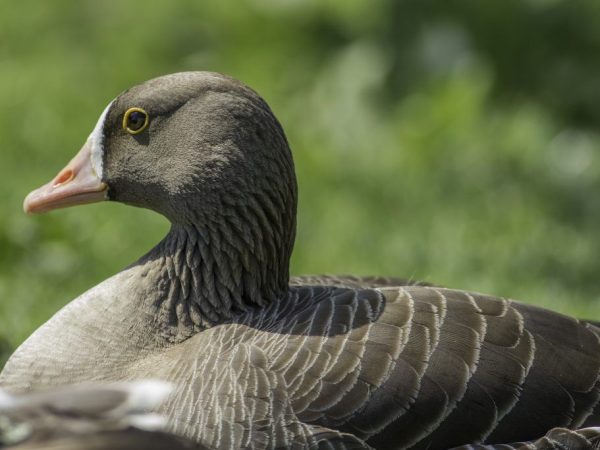Description of the white-fronted goose
The white-fronted goose is one of the favorite birds of hunters. Hunting goose (second, older name) is officially allowed due to the high population, which will not decrease from a couple of dozen killed birds of this species. Excellent taste of meat, ease of preparation make the poultry worthy of the main dish on the table during family holidays.

White-fronted goose
Description of appearance
The white-fronted goose resembles a gray goose in appearance, but it is slightly smaller in size. When a white-fronted chick is born, it is difficult to distinguish it from a gray congener. Only by the age of 4 can you see the features that distinguish this breed from others.
The description of the variety is as follows:
- the abdominal surface is white with transverse black spots;
- the beak in adults is pink;
- the frontal part of the head is white (hence the name of this goose species).
Mostly brown color predominates, which in some places is mixed with white feathers. Chicks up to a year have yellow legs with an orange tint. Adults are rich orange, closer to red. In the photo of the White-fronted goose from various Internet sources, you can clearly see the features and differences from birds of other species.
Male white-fronted goose in adulthood weighs 2 to 3.5 kg. Females weigh 2 to 3 kg. You can distinguish them from the gray geese from a distance by flight. It will be difficult for beginners, of course, to do this, but an experienced hunter will notice that White-fronted geese fly much smoother. Their movements are more graceful. An experienced hunter recognizes the voice of this bird by a higher tone compared to gray geese.
Location and lifestyle
The place of refuge for these birds is the tundra. In the tundra, the White-fronted goose feels safe, there, due to the peculiarities of the climate, humidity, flora, they nest in this area. European White-fronted geese winter near the Mediterranean, Caspian and Black Seas. Flocks of White-fronted geese fly in the same stream with the gray ones, but a little later, approximately in the middle of spring. During the flight, it is important that there is water in the form of lakes and rivers, as well as meadows, islands, where there is at least a small vegetation for feeding.
The White-fronted goose can spend the night not only on land, but also on water. This is quite rare, only when it is far from the coast. When the snow begins to melt in the tundra, the White-fronted goose comes to nest. This usually occurs in late spring - early summer. When the spring draws on, the winged flock lives on the shallows and grassy islands, where they wait for the weather suitable for incubating chicks.
From about 2 years of age, pairs form in the flock, which stick to each other during flights. Then some of them nest, and some arrive in the tundra much later, not wanting to build a nest for now.
Nesting
The habitat of geese is located in the tundra most of the time. Almost any place in these parts is suitable for incubating chicks. The main conditions are the presence of a freshwater lake or river, an average amount of grassiness. The nest can be located in an open area on a low bush.Eggs are on the flooring made from a mixture of down, dry and fresh grass. The flooring serves not only to protect the eggs from injury if they were lying on a hard floor. The female Bald Goose also uses the down as protection against possible external enemies. It covers eggs with fluff from the floor before flying off to get food.
The number of eggs in one nest varies from 1 to 7 pieces. The color is white, sometimes with a creamy tint. The size of the average egg is about 5 x 8 cm. While the female incubates the eggs, the male guards nearby. When the Arctic fox attacks, the pair stands in front of the nest and tries to scare away the predator with wide spread wings. Unfortunately, there are cases of death of geese.
If a person appears on the horizon, then the couple wait for his approach to about a distance of 30 m and take off at the same time. The birds cannot fly far from the nest, so they circle from above until the person leaves this place. Almost a month is the time for incubating eggs. The hatching process takes about 48 hours.
Food and wintering
Geese of the White-headed breed are herbivores. Their diet consists of algae, herbs, rhizomes, horsetails, etc. In winter, birds prefer berries. In July, young geese molt. They arrive in the tundra, a safe place provided with grass and water. Usually this is the coast of the Arctic, where there is a shallow lake and more or less grassy places. Adult bachelors also fly with young ones to moult, but this occurs later in older Bald geese.
In autumn, White-fronted geese gather in flocks. For about 2 months they prepare for long-distance flights, practicing short flights over the tundra. Training is needed. so that new young chicks, which have never flown before, get used to flying. At the end of November, White-fronted Geese are ready for a difficult journey. Adhering to rivers and lakes, flocks fly towards the west, south-west, south.
The white-fronted goose usually stays for the winter in Western Europe (Great Britain, the Netherlands). The lifespan of an individual is a little more than 15 years in freedom, in captivity the age can reach 25 years. These birds are not careful, therefore they often become victims of hunters. However, this does not affect the population, giving freedom of action to lovers of these geese.


